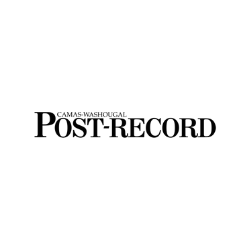The practice of gift giving has unique significance in many indigenous cultures. The practice shows respect to the receiver of the gift, as well as to their family members and ancestors. It is also a way to show appreciation for guidance or advice, or for assistance from those with distinct abilities such as healers or ceremonialists. Several tribes traditionally welcome visitors with gifts as well.
Standing in front of the newly dedicated Gathering Place at Washuxwal pavilion at the Two Rivers Heritage Museum on Sept. 18, Camas-Washougal Historical Society president Jim Cobb presented Sam Robinson, the vice chairman of the Chinook Indian Nation, with a gift both men hope will serve as a symbol of the partnership that the new pavilion represents.
The Chinook Indian Nation is made up of the five western-most Chinookan-speaking tribes at the mouth of the Columbia River — the Clatsop and Cathlamet (Kathlamet) of present-day Oregon and the Lower Chinook, Wahkiakum (Waukikum) and Willapa (Weelappa) of what is now Washington state.
“We hope our relationship with the tribe can get solid and we can work together with educational programs and use this place to help bring back the local history and stories of the past,” Cobb said to the small group of supporters and guests who gathered to celebrate the completion of the new pavilion.
Planning for the project began in 2015 when a landscape architect suggested to CWHS leaders that they should consider constructing some sort of pole building for meetings and gatherings. Efforts escalated in 2017 after CWHS members linked the building to the area’s indigenous culture and began fundraising efforts that eventually raised enough money for the $260,000 project.
“The community has been exceptional as far as the funding,” Cobb told the Post-Record In 2020.
The design of the pavilion, located on a 10,000-square-foot lot on the museum’s southern side, is based on the traditional cedar plank houses used by Native American tribes who called the Columbia River area home in the early 19th century.
Robinson told the group that longhouses “provided a lot for the people of this land.”
“You look around and notice one entrance,” he said. “The step in would drop as much as three feet. People would ask how the elders got inside. Well, we would pack them. Our elders were very important to us. They carried our knowledge; they were like our libraries, so we took care of them at all times.”
He also said that he refers to Chinook longhouses as the “first colleges in the Pacific Northwest.”
“In these buildings is where people would sit in the winter by the fire and learn from their grandparents, their aunts and uncles,” he said. “They would learn what it was like to be Chinook and how it was to be Chinook for tens of thousands of years on this Columbia River.”
With its inclusion of wood carvings, the pavilion pays homage to the area’s indigenous heritage and serves as an outdoor exhibit that can be used for cultural and community events and field trips.
“We are looking forward to using (the pavilion) to tell important stories of the earliest inhabitants of our area,” Cobb said.
During the ceremony, Cobb thanked project supporters, especially Michael Lewallen and Jason Ferrier of Lewallen Architects and Mark Albin of Able Hands Construction, for their efforts.
“Without Michael’s help, we could not have finished the project or even got it started,” Cobb said. “Jason was our designer and architect and so much more. And Mark was the one who set all of this up. He cut the inserts, put in the posts, put on the roof — he is the one who literally screwed the place together. Mark worked hard, and I can honestly say I don’t know of anyone else who could have done it.”
The Two Rivers Heritage Museum, located at 1 Durgan St., Washougal, will be open from 11 a.m. to 3 p.m. Oct. 9, 16, 23 and 30, then close until March 2022. Admission costs $5 for adults, $4 for seniors and $2 for students, and is free for children younger than 5 and CWHS members.
“We hope everyone will be interested in seeing this completed project and visit the museum before we are closed for winter maintenance starting in November,” Cobb said. “Just because we have finished the plank house doesn’t mean that we are done improving the Two Rivers Heritage Museum experience for the public and especially our local community.”
